
Jul 31, 2018. 4, /media/system/js/mootools-more.js, mootools. The Moskvitch-408 (also referred to as the Moskvich-408, and M-408) series is a small family car produced by the Soviet car manufacturer MZMA/AZLK between 1964.
MZMA Logo In 1929 the construction of Moscow Automotive Plant began with initial production of 24,000 vehicles. Between 1940 and 1941, it built the two-door compact car and its ' version.
In 1941, after having produced under 1,000 units, the plant was evacuated to and the entire production converted for the manufacture of military equipment after Hitler's invasion during. After the war, the production of the KIM cars was not resumed, and instead the Soviet Union acquired an manufacturing line from in of to manufacture the modified under the name in December 1946. In the 1950s and afterwards the factory, now called ( Moskovsky Zavod Malolitrazhnykh Avtomobiley, that is, Moscow Compact Car Factory), replaced it with its own cars developed by Soviet engineers: the second post-war generation consisting of the and, then by the more advanced,. The M-407 was the first Soviet automotive export to be truly successful in the West. Up to half of all M-407 production was exported for a number of years, mainly to the countries, Norway, Finland, and France.
Later models were also sold in Great Britain, Finland, and Norway, for instance, and in 1968, 55% of production was for export. In 1969, the factory changed its name to ( Avtomobilny Zavod imeni Leninskogo Komsomola, which means Automobile Factory in honor of Komsomol ). Moskvitch cars were sturdy, reliable on substandard roads and were offered at low cost. Demand always exceeded production, so people in the Soviet Union had to wait a long time for a new car. Until the 1980s all Moskvitch cars were compact and with solid rear suspended. The Moskvitch was also produced in (see ) between 1966 and 1990 on the basis of (CKD) kits.
Models 408, 408I, 412, 21412 'Aleko', total of 304,297 cars. In 1986 the became available for the first time. It was influenced by the (which was also badged as the Chrysler/Dodge Alpine, and under other names, in western markets).
It was upgraded and restyled during the period of its production. It was powered by the 1.5L UZAM used in the M-412 model and VAZ-2106 1.6L in-line four-cylinder engines, which had by then had been used in several models.
Aleko was different from any model the factory had made previously: it was larger and more luxurious, made with more comfort, and in mind. Harris unity radio programming software. The new car had such features as, a body style, front suspension and rear. It had rack-and-pinion steering and a collapsible.
The 1.8 liter for the new car was planned, but never materialized, as was also the case with a version. In the early 1990s AZLK still remained one of the largest auto companies in the. Design and experimental work was prepared to create a new model car ( M-2142) and an engine plant.
However, after the, due to a, disruptions in the work of the company and the engine plant was not finished and the Moskvitch company fell into decline. Because of its location, Moskvitch was in a more vulnerable position than companies located in other regions, as the cost of living and car production in Moscow began to grow rapidly. OAO Moskvitch [ ] The factory, which had been renamed to OAO Moskvitch ( Moskvitch Joint-Stock Company) in the early 1990s, filed for in 2002 and ceased production. Unfinished bodyshells remained on the production line in various stages of completion, while furniture, computers, office supplies, and documents remained in the plant's administration building. Several attempts to restart production have been made over the next 3 years, but none were successful. A portion of the abandoned plant was acquired by OAO Avtoframos, a 38%-62% joint venture between the City of and automaker SA.
In 2005, Avtoframos commenced assembly of sedans from imported complete knock-down kits (CKDs). The presence of Avtoframos brought new life to a small part of the facility, but the majority of the sprawling plant remains abandoned, apparently still owned by the dormant Moskvitch company.
The bankruptcy of OAO Moskvitch was officially announced in 2006 and the company was liquidated the following year. As of 2016, over a million Moskvitch cars remained on Russian roads. Since 2009, the owner of the brand Moskvitch is the German automotive company. [ ] In 2011, the company extended its brand ownership rights until 2021, a 10-year period. See also [ ] • • References [ ].